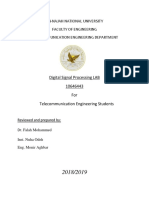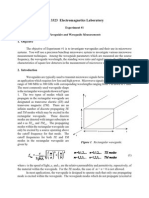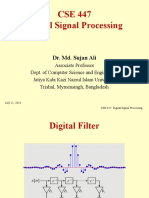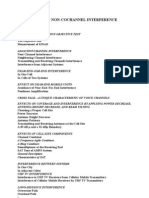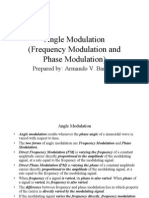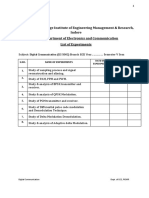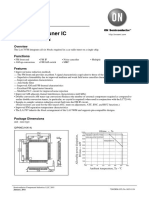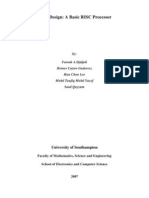Sampling and Reconstruction Trainer ST2101: An ISO 9001: 2000 Company
Sampling and Reconstruction Trainer ST2101: An ISO 9001: 2000 Company
Uploaded by
Anis MaqboolCopyright:
Available Formats
Sampling and Reconstruction Trainer ST2101: An ISO 9001: 2000 Company
Sampling and Reconstruction Trainer ST2101: An ISO 9001: 2000 Company
Uploaded by
Anis MaqboolOriginal Title
Copyright
Available Formats
Share this document
Did you find this document useful?
Is this content inappropriate?
Copyright:
Available Formats
Sampling and Reconstruction Trainer ST2101: An ISO 9001: 2000 Company
Sampling and Reconstruction Trainer ST2101: An ISO 9001: 2000 Company
Uploaded by
Anis MaqboolCopyright:
Available Formats
Sampling and
Reconstruction Trainer
ST2101
Operating Manual
Ver 1.1
An ISO 9001 : 2000 company
94-101, Electronic Complex Pardeshipura,
Indore- 452010, India
Tel : 91-731- 2570301/02, 4211100
Fax: 91- 731- 2555643
email : info@scientech.bz
Website : www.scientech.bz
Toll free : 1800-103-5050
ST2101
Scientech Technologies Pvt. Ltd. 2
ST21
Sampling and Reconstruction Trainer
ST2101
Table of Contents
1. Features 4
2. Technical Specifications 5
3. Theory 6
4. Pulse Amplitude Modulation 7
5. Nyquist Criterion 10
6. Effect of Duty Cycle on Information Recovery 11
7. Effect of Sampling and Sample / Hold Outputs 12
8. Important Parameters of Sampling and Hold Circuit 14
9. Low Pass Filters 17
Experiment 1 26
i) Study of Signal Sampling and Reconstruction Techniques
ii) Study of Nyquist Criteria and Aliasing
Experiment 2 29
i) Study of the effect of Sample /Hold Circuitry on Reconstructed
Waveform
ii) Effect of Sampling Pulse Duty Cycle on the Reconstructed
Waveform in Sample and Sample Hold Output
Experiment 3 32
i) Comparison of Frequency Response of 2nd order and 4th order
ii) Butterworth Low Pass Filter
10. Warranty 34
11. List of Accessories 34
Scientech Technologies Pvt. 3
ST21
Features
Crystal controlled pulse generator
Demonstrates sampling and reconstructed as per Nyquist criterion.
On-board analog generator synchronized.
Five Selectable Sampling Frequencies
Sampling pulse duty-cycle selectable.
Internal/ External sampling selectable.
Separate sample and sample/hold outputs available.
On-board second order and forth order low-pass Filters.
RoHS Compliance
d.
trictive use of Hazardous substances (Pb, Cd, Cr, Hg, Br compounds) in electric and electronic equipments.
d “Environment Friendly”.
use lead free solder wire and use the soldering irons upto (25 W) that reach a temperature of 450°C at the tip as the melting temperature of the unleaded s
Scientech Technologies Pvt. 4
ST21
Technical Specifications
Crystal Frequency : 6.4 MHz
Sampling Frequency : 2, 4,8,16 & 32 KHz (switch selectable)
On-board Generator : Synchronized 1 KHz sine wave (5Vpp)
Duty cycle : 0 - 90% in Decade steps
(Switch Selectable)
Low -Pass Filters : Butter Worth 2nd & 4th order
Cut-off frequency - 3.4 KHz each
Test Point : 51 in numbers
Interconnections : 4 mm sockets
Power Consumptions : 3 VA (approximately)
Power Supply : 230 V +/- 10%, 50Hz
Dimensions (mm) : W420 H100 D255
Weight : 2.5 Kgs. (approximately)
Scientech Technologies Pvt. 5
ST21
Theory
The aim of any communication system is to transmit information from one location to
another. In case of voice communication, this information will be speech.
The signal which contains the information to be transmitted is known as information
signal and in the case of voice communication this will be a continuously changing
signal containing speech information. The aim is to reproduce this information signal
as accurately as possible, at the distant, receiving end of the communication system.
In the exercises to follow, you will simulate audio signal by a 1 KHz test signal
provided On-board. The repetitive, non-changing (in amplitude, frequency or phase),
waveform does not contain information, but that does not mean we cannot use it.
Provided the frequency of the test-signal lies within the frequency range which an
information signal will occupy, a test signal of this type can be extremely helpful in
system analysis and testing.
The voice signals are limited to the range 300 Hz to 3.4 KHz, a 1 KHz frequency fits
conveniently in this range and can be used to demonstrate and test many techniques
used in communications.
Theory of Sampling :
In analog communication systems like AM, FM, the instantaneous value of the
information signal is used to hang certain parameter of the carrier signal.
Pulse modulation systems differ from these systems in a way that they transmit a
limited number. of discrete states of a signal at a predetermined time; sampling can be
defined as measuring the value of an information signal at predetermined time
intervals. The rate at which the signal is sampled is known as the sampling rate or
sampling frequency. It is the major parameter which decides the quality of the
reproduced signal. If the signal is sampled quite frequently (whose limit is specified
by Nyquist Criterion), then it can be reproduced exactly at the receiver with no
distortion.
Scientech Technologies Pvt. 6
ST21
Pulse Amplitude Modulation
The pulse amplitude modulation (PAM) system is analog system where the trains of
Pulses corresponding to the samples of each signal are modulated in amplitude in
accordance with the signal itself i.e. the height of the transmitted pulses varies with
the amplitude of the message. (Figure 1 & 2)
Basic Sampling Process
Figure 1
Sampled Output
Figure 2
PAM is an analog system because the amplitude of pulse can vary infinitely i.e.the
levels is not discrete.
An information signal sent through an ideal switch which is operated by a control
signal, isolated from the information signal, produces a PAM signal. When the switch
is open, the voltage is zero; when switch is closed the output voltage is equal to the
instantaneous signal voltage. The sample width depends upon how long a switch
remains closed.
Scientech Technologies Pvt. 7
ST21
Note : An ideal switch is free of delay and contact bounce problems.
In practice, electronic switching is used. Sampling by this method is same as
multiplying the information signal by a rectangular pulse train. Let us see how the
signal can be recovered from PAM signal.
Let the information signal m (t) of highest frequency component Fm (known as the
base band signal) is applied to a multiplier along with a train of pulses of unit
amplitude, width dt and period Ts. The output of the multiplier is S (t) m (t).
Figure 3
As it can be seen from above figure 3 the multiplier output has some value as m (t)
when the pulse occurs, otherwise it is zero. Rectangular waveforms can represented as
summation of Sine/Cosine waveforms of fundamental frequency plus infinite number
of harmonics.
Since PAM is amplitude modulation of pulse, we expect the sidebands to be formed
around fundamental frequency and each harmonics.
If the sampling frequency is Fs, the frequency spectrum of the PAM signal is as
shown below figure 4.
Scientech Technologies Pvt. 8
ST21
PAM Frequency Spectrum
Figure 4
As it can be seen from the figure the spectrum of PAM signal is very much similar to
that of AM signal, except the following :
1. The PAM signal contains the spectrum of the base band signal unlike that in
and where it is absent it is due to this fact that we can recover the original
signal.
2. In AM, a fixed amplitude carrier component is also present at the un-
modulated frequency fc. In PAM no such component exists in PAM spectrum.
The information signal can be recovered from the PAM signal by using a low pass
filter of cut-off frequency FM.
Scientech Technologies Pvt. 9
ST21
Nyquist Criterion
As shown-in the figure 5 the lowest sampling frequency that can be used without the
sidebands overlapping is twice the highest frequency component present in the
information signal. If we reduce this sampling frequency even further, the sidebands
and the information signal will overlap and we cannot recover the information signal
simply by low pass filtering. This phenomenon is known as fold-over distortion or
aliasing.
Figure 5
Nyquist Criterion (Sampling Theorem)
The Nyquist criterion states that a continuous signal band limited to F m Hz can be
completely represented by and reconstructed from the samples taken at a rate greater
than or equal to 2Fm samples/second.
This minimum sampling frequency is called as Nyquist Rate i.e. for faithful
reproduction of information signal fs > 2 fm.
Scientech Technologies Pvt. 1
ST21
Effect of Duty Cycle on Information Recovery
The duty cycle of a, signal is defined as the ratio of pulse duration to the pulse
repetition period. This ratio can also be expressed as percentage, e.g. the square wave
has equal pulse and no pulse duration, and hence its duty cycle is 0.5 or 50%.
The duty cycle of the sampling pulses is an important parameter in PAM system.
They govern the following important aspects:
1. The narrower pulses allow us to time division multiplex many such PAM
signals i.e. we can send many no. of PAM signals over same channel at a time.
Hence lower duty cycle beneficial in this respect.
2. The narrower pulses has wider frequency spectrum. Hence the wider bandwidth
channel is required.
3. Narrower pulses have less power as the power content of a pulse depends on its
amplitude and width. During transmission and demodulation the inherent noise
can play a major havoc on the low power signal. Hence a pulse of larger duty-
cycle is desirous for this sake.
In practice an engineering compromise is made between narrower and broader pulse
width taking into account the efficiency, requirement and inherent noise of the
system.
Note : The frequency spectrum of PAM signal does not contain those harmonics
which when multiplied by duty cycle results in an integer. e.g. the square wave with
duty cycle 0.5 (50%), does not contain even harmonics as they result in An integer
when multiplied with duty cycle. Thus a square wave sampling signal only contains
odd harmonics.
Scientech Technologies Pvt. 1
ST21
Effect of Sample and Sample / Hold Outputs
If the pulse width of the carrier pulse train used in natural sampling is made very short
compared to the pulse period, the natural PAM is referred to as instantaneous PAM
As it has been discussed, shorter pulse is desirous for allowing many signals to be
included in TDM format but the pulse can be highly corrupted by noise due to lesser
signal power.
One way to maintain reasonable pulse energy is to hold the sample value until the
next sample is taken. This technique is formed as sample-and-hold techniques. The
sample-and-hold waveform looks as shown in figure 6.
Sample & Hold Waveform
Figure 6
Now, the area under the curve (which is equivalent to the signal power) is greater and
so the filter output amplitude and quality of reproduced signal is improved.
The 'hold' facility can be provided by a capacitor when the switch connects the
capacitor to PAM output it charges to the instantaneous value.
A buffered sample and hold circuit consists of unit gain buffers preceding and
succeeding the charging capacitor. The high input impedance of the preceding buffer
prevents the loading of the message source and also ensures that the capacitor charges
by a constant rate irrespective of the source impedance see figure 7.
Scientech Technologies Pvt. 1
ST21
Sample Hold Circuit
Figure 7
The high input impedance of the succeeding buffers prevents the charge from the
capacitor due to loading and hence the capacitor can hold the charge for infinite time,
at least theoretically. However, small leakage current through the capacitor dielectric
into '+'ve input of second buffer is always present which causes gradual charge loss.
The rate of change of voltage with respect to time dv / dt is called as droop rate and is
important parameter in sample and Hold circuit design.
Scientech Technologies Pvt. 1
ST21
Important Parameters of Sample & Hold Circuit
1. Aperture time :
The aperture time is defined as the delay time between the beginnings of the hold
command to the time the capacitor voltage ceases to follow the information signal.
Hence the hold value is different from the true sample value. The aperture time cannot
be reduce to zero because on application of finite time taken by a switch to closet
open on application of the hold signal. Therefore a small value of aperture time is
sought after.
Timing Diagram for Sample And Hold Circuit
Figure 8
2. Acquisition Time :
In sample mode, it takes finite time for the capacitor to charge to the information
signal value depending on the RC time constant. This is called as the acquisition time.
The acquisition time is dependent on the current flowing from the input buffer
through switch and hence on RC time constant. The maximum acquisition time occurs
when the capacitor voltage has to change by the full amplitude of the information
signal.
3. Drop Rate :
As it has been discussed earlier, the presence of leakage current through capacitor
dielectric to +ve input of succeeding buffer causes charge loss of capacitor. Hence the
voltage level at the output falls with time. This rate of change of voltage with respect
to time dv/dt is known as droop rate. Over value of droop rate is desirable as the
circuit should be able to maintain the sample at a relatively constant level until the
next sample.
Scientech Technologies Pvt. 1
ST21
4. Feed Through :
At high frequencies, the stray capacitance within the switch causes some of the input
signal to appear at the output during the hold state (switch open). The fraction of input
signal appearing at the output of sample and hold circuit is called feed through.
The sample and hold feature provides both problem and benefit will be seen
afterwards.
Aliasing :
If the signal is sampled at a rate lower than stated by Nyquist criterion, then there is
an overlap between the information signal and the sidebands of the harmonics. Thus
the higher and the lower frequency components get mixed and cause unwanted signals
to appear at the demodulator output. This phenomenon is turned as aliasing or fold
over distortion. The various reasons for aiasing and its prevention are as described.
1. Aliasing due to Under-Sampling :
If the signal is sampled at rate lower than 2F m then it causes aliasing. Let us assume a
sinusoidal waveform of frequency F IN which is being sampled at rate F s < 2Fm. In the
figure 9 dots represents the sample points.
Aliasing due to Under - Sampling
Figure 9
The low-pass filter at demodulator effectively 'joins' the sample causing an unwanted
frequency component to appear at the output. This unwanted component has
frequency equal to (FS-FM)
Scientech Technologies Pvt. 1
ST21
2. Aliasing due to wide Band Signal :
The system is designed to take samples at frequency slightly greater than that stated
by Nyquist rate. If higher frequencies are ever present in the information signal or it is
affected by high frequency noise then the aliasing will occur.
This does not generally happen in properly designed telephone network where speech
channels are band-limited by filters before sampling.
In control engineering and telemetry, however, out of band high frequencies either
from source or due to noise pick-up can be present. In this case band-limiting filters,
generally known as anti-aliasing filters are usually installed prior to sampling to
prevent aliasing.
As a principle, the system is designed to sample at rate higher than the rate to take
into account the equipment tolerances, ageing and filter response.
3. Aliasing Due to Filter Roll-off :
Roll-off is a term applied to the cut-off gradient of a filter. No filter is ideal and
therefore frequencies above the nominal cut-off frequency may still have significant
amplitudes at a filter's output. If proper sampling rate and appropriate filter response
is not chosen, aliasing will occur.
4. Aliasing due to Noise :
If very small duty cycle is used in sample-and-hold circuit aliasing may occur if the
signal has been affected by noise. High frequency noises generally ‘mix’ with the
high frequency component of the signal and hence causes undesirable frequency
components to be present at the output.
Scientech Technologies Pvt. 1
ST21
Low Pass Filters
The PAM system the message is recovered by a low pass filter. The type of filter used
is very important, as the signal above the cut-off frequency would affect the recovered
signal if they are not attenuated sufficiently.
Filter Basic :
The simplest type of filter is a resistance-capacitance (RC) filter. The pass filter and
low pass RC filters are as shown in figure 10.
The analysis of these filters becomes easier if we think of them as a.c. potential
dividers. The reactance of the capacitor is frequency dependent with a high value at
low frequencies and a low value at high frequencies.
Passive High Pass Filter
Figure 10 (a)
Passive Low Pass Filter
Figure 10 (b)
In case of high pass filter, the series capacitance has high reactance at low frequencies
and hence results in reduction in output voltage. An increase in frequency causes an
increase in output voltage with VOUT approaching input voltage VIN.
The effect of capacitance is just opposite case of low pass filter. Here, the capacitance
is in short and hence VOUT reduces as frequency increases thereby decreasing its
reactance.
Scientech Technologies Pvt. 1
ST21
The ratio of VOUT: VIN is known as Transfer function for the circuit. For RC low pass
filter, the transfer function can be derived by using potential divider resistance.
So, V OUT 1
=
VIN 1+2R2C2
1 V OUT1
If = ------ then --------- = ----- = 0.707 = -3db
RC V IN 2
This is the half-power point of the filter i.e. at frequency = RC, the output power
decreases to half of the input power. This is also known as the cut-off frequency (Fc).
The filter not only causes amplitude change but a change in phase is also experienced.
A typical response of a low pass filter is as shown below:
Gain Response of Passive Filter
Figure 11(a)
Scientech Technologies Pvt. 1
ST21
Phase Response of Passive Filter
Figure 11(b)
The RC filter is a passive filter and does not give a steeper fall-off. Cascading many
such RC Filters give a steeper full-off but at a price of successive attenuation of the
signal.
Active filters give much flatter response in the pass band and they also have a steeper
cut-off gradient. The following figure shows a comparison between two types of filter
responses.
Amplitude Response of Active & Passive Filters
Figure 12
Scientech Technologies Pvt. 1
ST21
The other advantages offered by Active Filters are
1. Gain frequency adjustment flexibility (i.e. easy turning).
2. No loading problem between source, load or successive stages.
3. They are economical than passive filters.
The active filters employ transistors or op-amps in addition to resistor and capacitor.
The resistors at the output of the op-amp create a non-inverting voltage amplifier of
voltage gain K while other resistor and capacitor sets the frequency response
properties of the filter.
An ideal filter should have zero loss in pass band and infinite loss in stop band. In
practice no ideal response exists, but there are many responses which approximate the
ideal response namely,
Butterworth, Chebyshev, Bessel etc. the comparison of these filter responses are as
shown in figure 13.
Comparison of Filter Responses
Figure 13
The voltage controlled voltage source (VCVS) can be arranged in the following
manner to get the butterworth response. The same arrangements with different
component values give different response function/characteristics figure 14.
Scientech Technologies Pvt. 2
ST21
Second Order Butterworth Low Pass Filter
Figure 14
The nth order filter has a rate of fall off of 6n dB/octave or 20n dB/decade and one
capacitor or inductor is required for each pulse (order).
The following table summaries the effect of fall-off gradient-on a signal such-as
square wave.
Filter order fall-off Octave fall-off decade Phase at cut-off
frequency
First 6 20 - 45
Second 12 40 - 90
Fourth 14 80 - 180
See figure 15.
The amplitude response of a Butterworth filter is given by;
VOUT 1
-------- = ---------------- Where n is the order of the filter
VIN 1+ (f / fc)2n
Scientech Technologies Pvt. 2
ST21
Figure 15
Scientech Technologies Pvt. 2
ST21
Frequency Response of a Second Order Butterworth Low Pass Filter :
The arrangement shown in figure 14 can be used as second order butter worth filter
with cut-off frequency.
1
Fc =
2RC
The amplitude and phase response of second order butter worth low pass filter with
respect to frequency is as shown in figure 16.
Frequency (Normalized)
Amplitude Vs Frequency & Phase Vs Frequency
Response of Second Order Butterworth Low Pass Filter
Figure 16
For this circuit, the voltage gain has been set equal to 1.586.
Scientech Technologies Pvt. 2
ST21
Fourth Order Butterworth Low Pass Filter :
The fourth order Butterworth filter can be formed by cascading two second order
Butterworth filters. As can be seen from figure 17 the components R, and C are
identical in both filter stages and they determine the cut-off frequency. In our circuit
the gain of first stage has been set to 1.152 and that of other is set at 2.235.
Fourth Order Butterworth Low Pass Filter
Figure 17
The amplitude/frequency and phase/frequency responses of fourth order Butterworth
low pass filters are as shown in figure 18.
Amplitude Vs Frequency & Phase Vs Frequency
Response of Second Order Butterworth Low Pass Filter
Figure 18
The filter design should be done critically so that any unwanted frequency component
existing close to the desired frequency component attenuate sufficiently to save the
output from getting corrupted.
Scientech Technologies Pvt. 2
ST21
Though increasing order filter is desirable, there is a price that we have to pay for
steeper fall-off.
1. Additional circuitry increases complexity and cost
2. Increase in order increases phase lag, though it is not so critical in audio circuits.
Summary of PAM System :
Although PAM System, provides an useful technique of sampling and multiplexing in
time domain, its use is a communication system in practice is fairly limited. This is
due to the fact that PAM like AM & FM is an analog communication system which is
fairly sensitive to noise and distortion and in turn it does bit differing in significant
improvement over analog methods in terms of power conversion or bandwidth
occupancy etc. PAM System offers the following advantages:
1. It is used as a first stage of a digital communication system where the sampled
values are converted into more useful binary (I&O) modulation systems.
2. Allows time division multiplexing (TDM) of several information signals.
Testing Instruments needed for Experiments
(1) Scientech Oscilloscope Model 201
20 MHz, Dual Trace, ALT Trigger
(2) Oscilloscope Probes X1– X 10 etc.
Scientech Technologies Pvt. 2
ST21
Experiment 1
Objective :
1. Study of signal sampling and reconstruction techniques
2. Study of Nyquist criteria and aliasing.
Procedure :
1. Connect the mains plug into the mains board. Keep the power switch in ‘Off’
position.
2. Ensure that the 'External/Internal' Sampling Selector switch is in 'Internal'
position.
3. Put the Duty Cycle Selector Switch in position 5.
4. Link 1 KHz Sine wave output to Analog Input.
5. Turn ‘On’ the trainer
6. After turning ‘On’ the trainer selects 32 KHz sampling rate by default.
7. Display 1 KHz sine wave (TP12) and Sample Output (TP37) on an oscilloscope.
The display shows 1KHz. Sine wave being sampled at 32 KHz, so there are 32
samples for every cycle of the sine wave. (figure 19)
8. Link the Sample output to Fourth Order low pass Filter display Sample Output
(TP37) and the output of filter (TP46) on the oscilloscope. The display shows
the reconstructed original 1 KHz sine wave. (figure 20)
9. By successive presses of Frequency Selector switch, change the sampling
frequency to 2KHz, 4KHz, 8KHz, 16KHz and back to 32KHz (Sampling
frequency is 1/10th of the frequency indicated by the illuminated LED). Observe
how SAMPLE output changes in each cases and how the lower sampling
frequencies introduce distortion into the filter output waveform. This is due to
the fact that the filter does not attenuate the unwanted next frequency
component significantly. Use of higher order filter would improve the output
waveform.
10. So far, we have used sampling frequencies greater than twice the maximum
input frequency. To study Nyquist criteria, set sampling rate of 8KHz, 50% duty
cycle.
11. Remove the link from 1 KHz sine wave output to the Signal Input.
12. Obtain a 2V peak, 2KHz Sine wave from 600 ohms output of the function
generator to Signal Input. Observe the waveform at Signal Input and fourth
order low pass filter output (TP46). Observe the two are similar but the second
logging in phase. This is as expected from filters phase/ frequency response.
13. Decrease the sampling rate to 32 KHz and then to 2KHz. Observe the distorted
waveform at filter's output (TP46). This is due to the fact that we under-sampled
the input waveform overlooking the Nyquist criteria and thus the output was
distorted even though the signal lie below the cut-off frequency of the filter.
This also describes the phenomenon of Aliasing.
Scientech Technologies Pvt. 2
ST21
Figure 19
Scientech Technologies Pvt. 2
ST21
Figure 20
Scientech Technologies Pvt. 2
ST21
Experiment 2
Objective :
1. Study of the effect of Sample /Hold circuitry on reconstructed waveform
2. Effect of sampling pulse duty cycle on the reconstructed waveform in
sample and sample hold output
Procedure :
1. Follow step 1 to 5 as in Experiment 1.
2. Turning 'On' the trainer, selects 32 KHz sampling rate by default. Observe the
Sample output (TP37) and the Fourth Order low pass filter’s output (TP46).
3. Vary the position of Duty Cycle Selector switch from 0% to 90% (position 0 to
9), Observing how the Sample Output changes and how the amplitude of filter's
output changes. This amplitude increase; in early as the duty cycle is increased
from 10% to 90%.
4. Disconnect the Sample Output from filter input. Link Sample & Hold output to
Fourth Order low pass Filter's Input. Set the Duty Cycle Selector switch to
position '5' (50%). (figure 21)
5. Observe the waveform at Sample & Hold output (TP39) on oscilloscope. Vary
the sampling frequency to illustrate how each sample is held at the sample/hold
output. Also observe the filter output at TP46. (figure 22)
6. Vary the sampling pulse duty cycle from 0% to 90% and note that in contrast to
step 3, the filter's output amplitude is now independent of the sampling duty
cycle and is equal to the amplitude of the original signal input. This is an
important result - with Sample and Hold Output, the proportion of sampling
time to holding time has no effect on reconstructed waveform provided that
Nyquist criteria has been followed. In practical digital communication, this
result is very useful as the use of narrow pulses let many channels to be
multiplexed with maximum amplitude of reconstructed signal if sample/hold
feature is utilized in communication system.
Scientech Technologies Pvt. 2
ST21
Figure 21
Scientech Technologies Pvt. 3
ST21
Figure 22
Scientech Technologies Pvt. 3
ST21
Experiment 3
Objective :
1. Comparison of frequency response of 2nd order and 4th order.
2. Butterworth low pass filter.
Procedure :
1. Follow step 1 to 5 as in Experiment 1.
2. Link 1 KHz Sine wave output to Signal Input. Add a link from SAMPLE output
to input of the Second Order Low Pass Filter and to the input of Fourth Order
Low Pass Filter. Observe the outputs of two filters (TP42 and 46 respectively)
on the oscilloscope. Vary the sampling frequency with duty cycle set at 50%.
Compare the output of filter in each case. Note, that the output of fourth order
filter always exhibits less distortion than second order filter. This is because
fourth order filter has a sharper roll-off and thus rejects (attenuates) more
unwanted frequency components caused by sampling. (figure 23).
3. Also compare the phase lag between input and output for each filter.
4. Repeat the above procedure with sample and hold circuitry. Does the output
exhibits less distortion as compared to output in case of sample circuitry?
5. Disconnect all the links.
6. Using a function generator of 600 ohms impedance applies sine wave of 2V
peak at 100Hz output to Second Order Filter Input. Note the peak output value
(at TP42) and the phase difference between input and output. Vary the
frequency at steps of 200Hz /500Hz to 35 KHz. sketch the amplitude/frequency
and phase/frequency response of the second order filter. What is the cut-off
gradient of the filter/decade? What is the phase lag at filter's cut-off frequency?
7. Repeat the above steps with fourth order filter, which one of the two filter's cut-
off has more gradient? What is the phase lag input and output?
Scientech Technologies Pvt. 3
ST21
Figure 23
Scientech Technologies Pvt. 3
ST21
Warranty
1. We guarantee the product against all manufacturing defects for 24 months from
the date of sale by us or through our dealers. Consumables like dry cell etc. are
not covered under warranty.
2. The guarantee will become void, if
a) The product is not operated as per the instruction given in the operating
manual.
b) The agreed payment terms and other conditions of sale are not followed.
c) The customer resells the instrument to another party.
d) Any attempt is made to service and modify the instrument.
3. The non-working of the product is to be communicated to us immediately giving
full details of the complaints and defects noticed specifically mentioning the
type, serial number of the product and date of purchase etc.
4. The repair work will be carried out, provided the product is dispatched securely
packed and insured. The transportation charges shall be borne by the customer.
List of Accessories
1. Patch Cord 8"................................................................................................4 Nos.
2. Patch Cord 16"..............................................................................................2 Nos.
3. Mains Cord.....................................................................................................1 No.
4. e-Manual.........................................................................................................1 No.
5. CD (Demo VCD) Providing with Full Set Only.
6. DCT Book Providing with Full Set Only.
Updated 28-01-2009
Scientech Technologies Pvt. 3
You might also like
- Adc Mod 4Document130 pagesAdc Mod 4anuNo ratings yet
- ST2101Document34 pagesST2101sandeep_hot100% (1)
- Scientech 2201: DSB/SSB AM TransmitterDocument1 pageScientech 2201: DSB/SSB AM Transmitterlusoegyi 1919No ratings yet
- St2151w ManualDocument72 pagesSt2151w ManualYeshwanth Krishna KolliNo ratings yet
- Dcom Mod4Document4 pagesDcom Mod4Vidit shahNo ratings yet
- DSPDocument19 pagesDSPگيدوڙو ماڇي0% (3)
- Chapter 4 Digital Mod - Part 2 - 2Document33 pagesChapter 4 Digital Mod - Part 2 - 2Bhern Bhern100% (1)
- δ (n) = u (n) - u (n-3) = 1 ,n=0Document37 pagesδ (n) = u (n) - u (n-3) = 1 ,n=0roberttheivadasNo ratings yet
- Pulse Amplitude Modulation: ObjectiveDocument8 pagesPulse Amplitude Modulation: ObjectiveRufaelNo ratings yet
- UNIT-4 FinalDocument70 pagesUNIT-4 FinalanandbabugopathotiNo ratings yet
- Applications of DSPDocument11 pagesApplications of DSPRajkeen ChamanshaikhNo ratings yet
- ECE4007 Information-Theory-And-Coding ETH 1 AC40Document3 pagesECE4007 Information-Theory-And-Coding ETH 1 AC40harshitNo ratings yet
- 5,6 Ldic New Course FileDocument49 pages5,6 Ldic New Course FileTarun PrasadNo ratings yet
- Performance Analysis of Higher Order ModulationDocument30 pagesPerformance Analysis of Higher Order ModulationMintesnot HamleNo ratings yet
- 19 Pre-Emphasis and De-EmphasisDocument8 pages19 Pre-Emphasis and De-EmphasisMohamed ShabanaNo ratings yet
- Traffic Analysis and Characterization - Test 2Document50 pagesTraffic Analysis and Characterization - Test 2Sarah BhallaNo ratings yet
- Sequential Circuits: Digital ElectronicsDocument10 pagesSequential Circuits: Digital ElectronicsAshu1803No ratings yet
- Lab Report: Amplitude ModulationDocument6 pagesLab Report: Amplitude ModulationAsith SavindaNo ratings yet
- Ec51 Digital CommunicationDocument18 pagesEc51 Digital CommunicationvijayprasathmeNo ratings yet
- Digital Signal Processing Lab 2018 2019 2Document149 pagesDigital Signal Processing Lab 2018 2019 2Ahmed Aleesa100% (2)
- Ece 3323 Experiment 1Document11 pagesEce 3323 Experiment 1TANQUERO_WW20% (2)
- Laboratory Manual On Analog Communication Techniques (2003)Document31 pagesLaboratory Manual On Analog Communication Techniques (2003)Chandra MohantyNo ratings yet
- Final PPT On Speech ProcessingDocument20 pagesFinal PPT On Speech ProcessingBhavik Patel0% (1)
- 1.7.3 Iir Filter DesignDocument34 pages1.7.3 Iir Filter DesignAkram SarrawyNo ratings yet
- BME 3111 S#5 Data Reduction TechniquesDocument28 pagesBME 3111 S#5 Data Reduction TechniquesMuhammad Muinul Islam100% (1)
- DIGITAL COMMUNICATION Unit 2 VTU PDFDocument75 pagesDIGITAL COMMUNICATION Unit 2 VTU PDFHarsh Kapoor100% (1)
- 4 CSE 447 Digital FilterDocument82 pages4 CSE 447 Digital FilterAriful Islam ShantoNo ratings yet
- PN Sequence Generator PDFDocument8 pagesPN Sequence Generator PDFabi100% (3)
- PTSP Notes Unit 3 PDFDocument11 pagesPTSP Notes Unit 3 PDFG S ArunNo ratings yet
- Introduction To Discrete Time Signals & SystemDocument119 pagesIntroduction To Discrete Time Signals & SystemMahesh Abnave100% (1)
- Microprocessor Unit 4Document55 pagesMicroprocessor Unit 4Vekariya KaranNo ratings yet
- CH 4 FFT PDFDocument57 pagesCH 4 FFT PDFArundhati ChaudhariNo ratings yet
- Types of NON-COCHANNEL INTERFERENCEDocument1 pageTypes of NON-COCHANNEL INTERFERENCEroyfadliNo ratings yet
- Unit-2 - Kec503 DSP - 2023-24Document22 pagesUnit-2 - Kec503 DSP - 2023-24shubhNo ratings yet
- CT NotesDocument227 pagesCT NotesAnonymous ODLmPN5g100% (3)
- FM Modulators: Experiment 7Document17 pagesFM Modulators: Experiment 7banduat83No ratings yet
- Filter DesignDocument9 pagesFilter DesignTaylor MaddixNo ratings yet
- Experiment no. 2 Aim: - Theory: c1 (t) = √2/Tb cos 2πƒ1tDocument6 pagesExperiment no. 2 Aim: - Theory: c1 (t) = √2/Tb cos 2πƒ1tMudit GoelNo ratings yet
- DC CheatsheetDocument2 pagesDC CheatsheetRashi SinghNo ratings yet
- Chapter 6 Part 1 - HandoutDocument24 pagesChapter 6 Part 1 - Handoutmeseret sisayNo ratings yet
- chapter_2 Wiener FiltersDocument25 pageschapter_2 Wiener FilterssaadmuheyfalhNo ratings yet
- Electronic Communications Presentation Materials Part 3Document94 pagesElectronic Communications Presentation Materials Part 3MJ VergaraNo ratings yet
- UNIT - 3: Fast-Fourier-Transform (FFT) Algorithms: Dr. Manjunatha. PDocument100 pagesUNIT - 3: Fast-Fourier-Transform (FFT) Algorithms: Dr. Manjunatha. PMVRajeshMaliyeckalNo ratings yet
- CELPDocument23 pagesCELPANeek181No ratings yet
- Chapter 4-Angle Modulation and DemodulationDocument48 pagesChapter 4-Angle Modulation and DemodulationElias HedamoNo ratings yet
- Lecture 20 Preemphasis - Deemphasis in FM CircuitsDocument15 pagesLecture 20 Preemphasis - Deemphasis in FM CircuitsMr. MERLIN GILBERT RAJ S 1154No ratings yet
- Sampling Theorem Verification: Electronics & Communication EngineeringDocument0 pagesSampling Theorem Verification: Electronics & Communication Engineeringagama1188No ratings yet
- The Sonometer: L N L N NDocument3 pagesThe Sonometer: L N L N NSubhankar DeyNo ratings yet
- Chapter 10 Microwave DevicesDocument18 pagesChapter 10 Microwave DevicesAghna Tiyas MandalNo ratings yet
- Spectral Estimation NotesDocument6 pagesSpectral Estimation NotesSantanu Ghorai100% (1)
- Introduction To MIMO SystemsDocument14 pagesIntroduction To MIMO SystemsmazhaicNo ratings yet
- Da AssignmentDocument3 pagesDa AssignmentmadhurNo ratings yet
- Analog & Digital Communications Lab ManualDocument57 pagesAnalog & Digital Communications Lab ManualHarikrishnan Manakara Radhakrishnan100% (1)
- Spread SpectrumDocument41 pagesSpread Spectrummohan inumarthiNo ratings yet
- Digital CommunicationDocument45 pagesDigital CommunicationgsathyascewNo ratings yet
- DC ManualDocument62 pagesDC ManualnavecNo ratings yet
- Adc Lab ManualDocument48 pagesAdc Lab ManualanushkanikharaNo ratings yet
- PAM, PPM, PWM Modulation and Demodulation Trainer ST2110 LearningDocument67 pagesPAM, PPM, PWM Modulation and Demodulation Trainer ST2110 Learningchemavalencia100% (2)
- Data Communication PraticalDocument51 pagesData Communication PraticalDeepak MakhijaNo ratings yet
- Analogue and Digital Communication Lab ManualDocument95 pagesAnalogue and Digital Communication Lab ManualZara Zara100% (1)
- LA1787MDocument54 pagesLA1787MAgus BrewsNo ratings yet
- 15. Fifty_Applications_of_the_CMOS_InverterPart_1_The_Analog_MindDocument8 pages15. Fifty_Applications_of_the_CMOS_InverterPart_1_The_Analog_MindAram ShishmanyanNo ratings yet
- ECE 423 - Lect - 2 - Analog Electronic Volt-Ohm-Milliammeter - IDocument28 pagesECE 423 - Lect - 2 - Analog Electronic Volt-Ohm-Milliammeter - ISayed MashakelNo ratings yet
- (Analog Circuits and Signal Processing) Raj Senani, D. R. Bhaskar, A. K. Singh, V. K. Singh (Auth.) - Current Feedback Operational Amplifiers and Their Applications-Springer-Verlag New York (2Document263 pages(Analog Circuits and Signal Processing) Raj Senani, D. R. Bhaskar, A. K. Singh, V. K. Singh (Auth.) - Current Feedback Operational Amplifiers and Their Applications-Springer-Verlag New York (2legarcon55100% (2)
- Guide To FPGADocument472 pagesGuide To FPGADavid CamarenaNo ratings yet
- Practical: 3 Aim: Implement Common Bus System of Four 4-Bit Register Using 2x4 Decoder and Three State BufferDocument2 pagesPractical: 3 Aim: Implement Common Bus System of Four 4-Bit Register Using 2x4 Decoder and Three State BufferMahesh Pillai67% (3)
- TroubleshootingDocument35 pagesTroubleshootingtarafinou3312No ratings yet
- Polyswitch USER MANUALDocument7 pagesPolyswitch USER MANUALPaoloNo ratings yet
- VLSI Design: A Basic RISC ProcessorDocument54 pagesVLSI Design: A Basic RISC Processorhcg0206No ratings yet
- Boost Converter Using The PIC16F753 Analog Features: Performance SpecificationsDocument9 pagesBoost Converter Using The PIC16F753 Analog Features: Performance SpecificationsSheik Ashiq AmeerNo ratings yet
- Wien Bridge Oscillator With Real Amplifiers: September 2015Document39 pagesWien Bridge Oscillator With Real Amplifiers: September 2015Manoj KhatriNo ratings yet
- Tri-State Buffers and Schmitt Trigger.: Exp# 6 Exp. Name ObjectivesDocument4 pagesTri-State Buffers and Schmitt Trigger.: Exp# 6 Exp. Name ObjectivesTala JaberNo ratings yet
- Galaxy Service ManualDocument100 pagesGalaxy Service ManualGovind RajNo ratings yet
- DC 74HC7541PWDocument14 pagesDC 74HC7541PWNawazNo ratings yet
- Libro Circuitos EleDocument243 pagesLibro Circuitos EleCecilia Castillo CastelánNo ratings yet
- Amis 30532 D PDFDocument29 pagesAmis 30532 D PDFjorge luis guevara martinezNo ratings yet
- q.16) Operation of Positive and Negative ClippersDocument15 pagesq.16) Operation of Positive and Negative Clippersdharshini ravichandranNo ratings yet
- Ac Cathode FollowerDocument6 pagesAc Cathode FollowerPeter SilanganNo ratings yet
- Analog Circuit Design - Operational Amplifiers, Analog To Digital Convertors, Analog Computer Aided Design (PDFDrive)Document447 pagesAnalog Circuit Design - Operational Amplifiers, Analog To Digital Convertors, Analog Computer Aided Design (PDFDrive)Fernando Sánchez Hernández100% (1)
- HammerHead PI Metal Detector (HHv1p5)Document15 pagesHammerHead PI Metal Detector (HHv1p5)wladwolfNo ratings yet
- TLC 7225Document21 pagesTLC 7225tajpan77No ratings yet
- Transistors TutorialDocument92 pagesTransistors TutorialAmit Raj100% (18)
- Design of Cmos BufferDocument5 pagesDesign of Cmos BufferVarunKaradesaiNo ratings yet
- A High Performance CMOS Band - Gap Reference Circuit DesignDocument6 pagesA High Performance CMOS Band - Gap Reference Circuit DesignKhaja Mujeebuddin QuadryNo ratings yet
- Kelvin DividerDocument2 pagesKelvin DividerlonemubashirNo ratings yet
- Altera Ciclon 2Document130 pagesAltera Ciclon 2jovares2099No ratings yet
- pg4 ShureDocument35 pagespg4 Shurejoaquin espalterNo ratings yet
- Interview Questions With Answers: Ch.V.V.RamanaDocument16 pagesInterview Questions With Answers: Ch.V.V.Ramanaram12_leoNo ratings yet



















